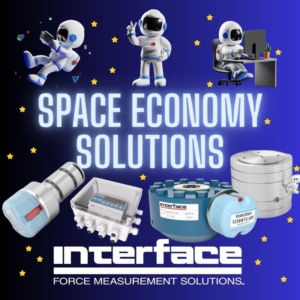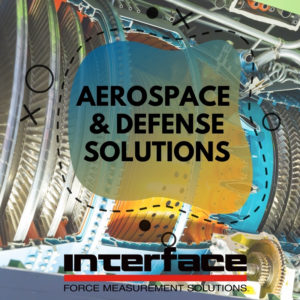Interface Space Economy Solutions
 The space economy is rapidly emerging as a leading platform for cutting-edge research, technology, and global economics. With a focus on endeavors such as lunar mining and deep space exploration, Interface is at the forefront of sensor technology, which is driving growth in this dynamic sector, as noted in our new Space Economy Solutions Overview.
The space economy is rapidly emerging as a leading platform for cutting-edge research, technology, and global economics. With a focus on endeavors such as lunar mining and deep space exploration, Interface is at the forefront of sensor technology, which is driving growth in this dynamic sector, as noted in our new Space Economy Solutions Overview.
The space economy encompasses various sectors, including satellite communication, Earth observation, space tourism, launch services, space manufacturing, and space mining, among others. It involves both public and private entities, including government space agencies, commercial space companies, and research institutions. As sustainability and digital technologies continue to reshape the global economy, Interface precision force measurement solutions are used in scientific research and development (R&D) and deep space discoveries, as noted in Enabling A Look Way Beyond Yonder. As a result, we are poised to play an increasingly critical role in testing the boundaries and opportunities in the space economy.
Leaders in the space sector are using force measurement products in their to design, build, test, secure and launch rockets into outer space. Interface has been involved in many of these projects with some of the space largest organizations in the world,as noted in our NASA case study. Interface sensor technologies are also used by innovators and education institutions around the world, like the Richard F. Caris Mirror Lab, that are exploring possibilities and testing inventions for our continued exploration and future inhabitation of other planets and galaxies.
Force Measurement Use Cases for Space Launches
There are numerous areas in which force measurement sensors are utilized on a space project. Everything from the motorized equipment at the launch site, to the rocket itself, can be tested using load cells, load pins, and more. Some of the areas in which Interface has been involved in providing solutions for includes structural testing on rockets, launch platforms and landing, commercial launch vehicles, space exploration equipment testing, and even in testing certain equipment used for space travel and food production.
- Structural Testing: Structural tests are critical to the launch process because the craft’s core components, such as the liquid hydrogen and oxygen tanks, wings, and fuselage, must withstand launch loads of up to nine million pounds of force (lbf). A few years ago, NASA’s Space Launch System (SLS) used Interface load cells to measure the core stage of the rocket. This particular core stage is one of the largest ever built at 27 feet in diameter and more than 200 feet tall.
- Thrust Testing: A rocket that is fully fueled and ready for launch can weigh up to five million pounds. Therefore, the force necessary to lift the rocket out of the earth’s atmosphere is immense. There are several other factors working against the rocket which need to be compensated for when adjusting thrust force such as drag. Interface has supplied load cells to many aerospace customers to test force and other contributing factors for lifting a rocket into space. These load cells work by being installed underneath a test plate which the rocket engine will sit on. As the engine thrusts, the load cells will calculate the force output of the engine in real-time. This data is used to optimize the engine to determine how much thrust force is needed based on the spacecraft’s total weight and the calculated drag at liftoff.
- Force Gravity Testing: Force measurement tools also serve many purposes outside of spacecraft testing in the aerospace industry. Interface was involved in a unique application of force measurement with a customer that wanted to develop a system to provide a full range of natural motion for a realistic simulation of reduced gravity environments. The system would be used to simulate weightlessness so astronauts’ crews could learn how to handle microgravity activities, including walking, running, and jumping. The system could also be used for surface operation studies, suit and vehicle development, robotic development, and mass handling studies.
EVENT ALERT! Interface will be showcasing how our load cells, load pins, load shackles, calibration equipement, and instrumentation are used by space technology companies around the world at Space Tech Expo, May 2-4 in Laguna Beach, California. You’ll find us in Booth 6057 where we we will be highlighting solutions, as captured here:
Space Economy Applications
Space Dock Capture Ring Force Testing Solution
A space company wanted to test their spacecraft docking simulator. They wisedh to test the forces of the actuators used during the “lunge”, when the soft capture ring is lunged forward to latch onto a space vehicle that has been mounted. They also wanted to ensure they are working properly when engaged, and that it does not go past its overload force limit. Interface suggested using multiple WTS 1200 Standard Precision LowProfile™ Wireless Load Cells to be installed to the actuators of the capture ring. Both as wireless solutions, measurements could be recordeded through the WTS-AM-1E Wireless Strain Bridge Transmitter Module, which then can transmit to the WTS-BS-1 Handheld Display or the WTS-BS-6 Wireless Telemetry Dongle Base Station for the customer to record, log, and graph on their computer. Interface’s Wireless Telemetry System successfully measured the forces of the soft capture ring of the space docking port with overload protection.
Rover Landing Gear Solution
A space company wanted to measure the cushioning effect of their rover’s landing legs through a drop test. They want to test how much force the landing gear can absorb until issues are caused in the legs. Interface suggested using the INFRD Platform Scale, which has four shear beam load cells installed at the corners of the scale. A drop test was conducted at different heights, and the results were summed using a JB104SS Junction Box built in the scale. The results are measured and logged on the provided SD card. Results can be also be viewed and logged when the 9330 connects to a PC. The INFRD Platform Scale was able to capture the forces that was implemented onto the rover’s landing gear through these drop tests.
Like many space technology companies, a very well known space exploration leader is utilizing force measurement to stabilize their rocket prior to launch. A YouTube channel named CSI Starbase, examined a few images from a recent launch construction project and pointed out the presence of Interface stainless steel load pins on the site. In the video, CSI Starbase concluded that the load pins pictured must be used for the hold down arms used on the booster of the rocket. This is one of many Innovative Interface Load Pin Applications.
Interface understands the advancements we are making in the space economy require high accuracy force measurement solutions. Interface offers a wide variety of solutions, both custom and off-the-shelf, for the ever expanding space economy, including sensors used for:
- Structural Testing
- Space and Flight Simulations
- Launch Vehicles and Spacecraft Tests
- Engine and Thrust Tests
- Spacewalks
- Robotics and Manipulators
- Space Habitats and Agriculture
- Planetary Exploration Vehicles
- Space Mining
- Space Vehicle Component Manufacturing
- Deep Space Exploration
- Space R&D
- Spacecraft Landing Gear Tests
- Rovers Vehicle Design and Testing
- Microgravity Tests
To highlight more of our solutions and provide background on the various ways we serve space customers, check out our new space economy overview.
Space Economy BrochureADDITIONAL RESOURCES
Vertical Farming on Earth and in Space
Examining Interface Aerospace Industry Solutions
Interface and The Race to Space


